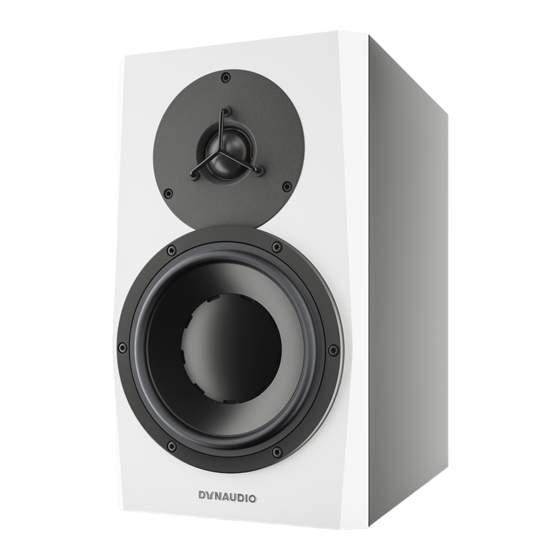
Table of Contents
Advertisement
Quick Links
Advertisement
Table of Contents

Summary of Contents for Dynaudio LYD
- Page 1 User manual...
- Page 2 Connecting the Speakers ▪ Mains ▪ Standby Mode ▪ Audio Signals ▪ Caution ▪ Adjusting the Volume ▪ DSP Settings ▪ Bass Extension ▪ Sound Balance ▪ Position ▪ Listening Tests ▪ Reference Material ▪ Pink Noise LYD User manual...
- Page 3 ▪ Final Tweaks ▪ First Reflection Treatment ▪ Bass Trapping...
- Page 4 LYD User manual...
-
Page 5: Things You Will Need
Dynaudio Meter App Dynaudio has created an iOS app that contains a source of pink noise, SPL meter, and RTA spectrum analyzer. This app is designed to assist you in positioning and calibrating your speaker system in the listening room. -
Page 6: Other Resources
Other Resources Please also visit our web site www.dynaudio.com You will find additional information including: ▪ Questions and answers about Dynaudio products and technical information ▪ Dynaudio events and news LYD User manual... -
Page 7: Important Safety Information
Important safety information The lightning flash with an arrowhead symbol within an equilateral triangle, is intended to alert the user to the presence of uninsulated “dangerous voltage” within the product’s enclosure that may be of sufficient magnitude to constitute a risk of electric shock to persons. The exclamation point within an equilateral triangle is intended to alert the user to the presence of important operating and maintenance (servicing) instructions in the literature accompanying the product. - Page 8 The recycling of materials helps to conserve natural resources. For more detailed information on recycling this product, please contact your local authority, community waste disposal of, or the shop where you purchased the product. LYD User manual...
-
Page 9: For Customers In Canada
EMC/EMI This equipment has been tested and found to comply with the limits for a Class B Digital device, pursuant to part 15 of the FCC rules. These limits are designed to provide reasonable protection against harmful interference in residential installations. This equipment generates, uses and can radiate radio frequency energy and, if not in- stalled and used in accordance with the instructions, may cause harmful interference to radio communications. -
Page 10: Product Overview
Product Overview The transducers of your Dynaudio LYD speaker will achieve better sound quality after breaking in. Especially after the first hours of use, you may notice a significant advance in sound quality, and further subtle improvements in subsequent hours of use. - Page 11 8. Sound Balance switch – Switches between three tilt filter settings 9. Position switch – Turns boundary effect filters ON/OFF Product Overview...
-
Page 12: Positioning The Speakers
LYD 5, 7 & 8 are designed to be positioned vertically and pointed directly at the listener, while the LYD 48 is designed to be used horizontally. - Page 13 Figure 4: Room diagram, walls, and ceiling Positioning the speakers...
- Page 14 The idea is to do the best you can with the limitations you have. Listening Distance The LYD 5,7 & 8 speakers are designed as near field monitors. Near field monitors should be placed relatively LYD User manual...
- Page 15 1 and 2 meters. LYD 48 can be used both as a near or mid field monitor. The ideal listening distance is between 1.5 and 2.5 meters. Speakers on the Desk These loudspeakers are designed to work well in a variety of positions, even very close, placed on the work surface in front of you.
- Page 16 Figure 6: Listening angle vertical LYD User manual...
-
Page 17: Connecting The Speakers
Connecting the Speakers Mains Ensure that you have the correct mains cable for your region. The power supplies in the loudspeaker have switching inputs that automatically detect the incoming voltage and will adjust to either 120V or 220V, depending on your location. Plug in the provided AC cable to the loudspeaker and then to the outlet. -
Page 18: Adjusting The Volume
If you are using a professional interface with a max output of +20dBu or more, then a setting of -6dB on the loudspeaker is the most appropriate. If you are using equipment that runs at a consumer or domestic output level (-10dBV nominal), then the +6dB setting is better. LYD User manual... -
Page 19: Dsp Settings
DSP Settings Dynaudio engineers have painstakingly created a DSP controller for these speakers that lets you tailor the sound to your particular environment. The DSP settings provide precision adjustments that optimize the speakers for the listening space. Bass Extension Low frequencies take an exponentially larger amount of energy to reproduce than high frequencies. That is why the bass extension setting affects how loud the speaker will respond. -
Page 20: Listening Tests
▪ Pink Noise Source Dynaudio has created an iOS app with these tools built in so you can quickly test and calibrate your LYD speakers using your iPhone, iPad or iPod touch. In the Apple App Store, search for “Dynaudio Meter” to locate and download this free app. -
Page 21: Final Tweaks
Final Tweaks Beyond the settings for the loudspeakers, additional tweaks may be desired to improve the response of the system and room environment. You may discover that a reflective surface is causing a high frequency anomaly or perhaps room modes are disturbing the bass response in the room. First Reflection Treatment Sound reflecting off of hard surfaces that are close to the listening position can cause problems in the high frequency response and imaging of the loudspeakers. - Page 22 Figure 7: Reflection diagram LYD User manual...
- Page 23 Designed and engineered by Dynaudio Labs in Denmark Dynaudio A/S 8660 Skanderborg Denmark dynaudio.com © 2022 Dynaudio A/S All text and image copyrights reserved. Subject to change without notice. Final Tweaks...
















Need help?
Do you have a question about the LYD and is the answer not in the manual?
Questions and answers